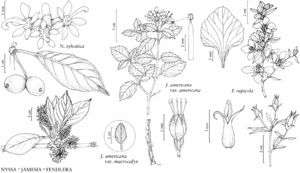Difference between revisions of "Nyssaceae"
FNA>Volume Importer |
FNA>Volume Importer |
||
| Line 45: | Line 45: | ||
|publication year= | |publication year= | ||
|special status= | |special status= | ||
| − | |source xml=https://jpend@bitbucket.org/aafc-mbb/fna-data-curation.git/src/ | + | |source xml=https://jpend@bitbucket.org/aafc-mbb/fna-data-curation.git/src/f6b125a955440c0872999024f038d74684f65921/coarse_grained_fna_xml/V12/V12_218.xml |
}}<!-- | }}<!-- | ||
-->[[Category:Treatment]] | -->[[Category:Treatment]] | ||
Revision as of 18:16, 24 September 2019
Shrubs or trees, deciduous, usually monoecious or polygamous, rarely dioecious. Leaves alternate, simple; stipules absent; petiole present; blade margins entire or sparsely, irregularly dentate; venation pinnate. Inflorescences unisexual, axillary [terminal], umbel-like or glomerate, or flowers solitary. Flowers bisexual or unisexual; perianth and androecium epigynous; hypanthium absent (staminate flowers), completely adnate to ovary (bisexual and pistillate flowers); sepals 5, connate; petals 5(–10), distinct; nectary present, intrastaminal; stamens (4–)6–12(–15) in 1–2 whorls, distinct, free; anthers dehiscing by longitudinal slits; pistil 1, 1(–2)[–3]-carpellate; ovary inferior, 1(–2)[–3]-locular, placentation apical; ovule 1 per locule, anatropous; styles 1(–2)[–3], connate basally; stigmas 1(–2)[–3]. Fruits drupes. Seeds 1 per locule.
Distribution
c, e North America, Mexico, Central America (Costa Rica, Panama), e Asia.
Discussion
Genera 2, species ca. 15 (1 genus, 5 species in the flora).
Taxonomic opinions about the status and circumscription of the Nyssaceae have varied. Nyssa and the small eastern Asian genera Camptotheca Decaisne and Davidia Baillon sometimes have been included in an expanded Cornaceae, a view supported by earlier phylogenetic studies (Xiang Q. Y. et al. 1998). The narrower circumscription used here, with the family comprising only Camptotheca and Nyssa but still close to Cornaceae, follows R. H. Eyde (1966) and is supported by phylogenetic studies by Xiang et al. (2011).
